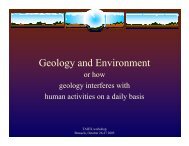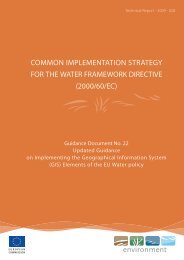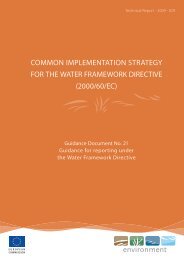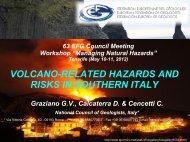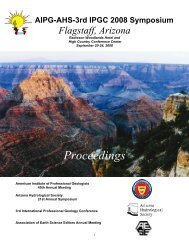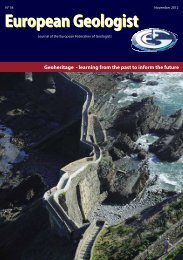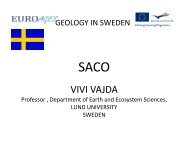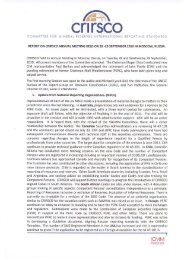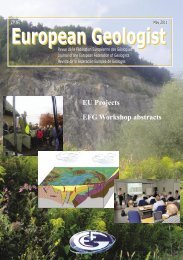EGM 30 download.pdf - European Federation of Geologists
EGM 30 download.pdf - European Federation of Geologists
EGM 30 download.pdf - European Federation of Geologists
You also want an ePaper? Increase the reach of your titles
YUMPU automatically turns print PDFs into web optimized ePapers that Google loves.
Euro-Ages and geology in SwedenThere are five Higher Education Institutesin Sweden producing graduatesin geology. Besides these universities,courses and programmes are also <strong>of</strong>feredin technical geology and marine geologyat several other schools in Sweden.However, these are usually <strong>of</strong>fered toengineers only. The Swedish universitiesadapted their education towardsthe Bologna process in 2007 and theHigher Education Institutes in Swedenhave basically the same framework fortheir geological education programmes.They are all organized according to theBologna process where education ingeology is based on a three-level scale;Bachelor (3 years), Masters (2 years),and Ph.D. (3 years). Every degree hasa fixed number <strong>of</strong> credits and a full year<strong>of</strong> studies equals 60 ECTS credits. Intotal 75-100 geology graduates comethrough the Swedish Universities peryear. The number <strong>of</strong> freshmen studentsentering the geological programmes isstable and unemployment rates are low,and continue to decrease.by Vivi Vajda 1 and Linda M. Larsson 2Il existe cinq Etablissementsd’Enseignement Supérieur en Suède,à l’origine des diplômés en géologie.Outre ces universités, des courset programmes en géotechniqueet en géologie marine sont égalementdispensés auprès de plusieursEcoles suédoises. Cependant, ilssont d’habitude l’apanage des seulsingénieurs. C’est en 2007 que les universitéssuédoises se sont conforméesau système d’éducation du processusde Bologne, basé sur les trois niveauxde qualification; Licence (3 ans), Maîtrise(2 ans) et Doctorat (3 ans).Chaque niveau comporte un nombredéfini d’unités de valeur et une annéecomplète représente 60 unités. Autotal, 75 à 100 diplômés en géologiesortent chaque année des universitéssuédoises. Le nombre d’étudiants enpremière année de cursus géologiqueest stable et le taux de chômage estfaible et en diminution.Hay cinco centros de educación superioren Suecia que producen graduadosen geología. Además de estas universidades,varias escuelas de Suecia <strong>of</strong>recencursos y programas en técnica geológicay geología marina. Sin embargo estosúltimos se <strong>of</strong>recen sólo a ingenieros. Lasuniversidades suecas adaptaron su sistemaeducativo al proceso de Bolonia en2007 y los centros de educación superiorsuecos tienen el mismo marco de referenciapara sus programas de educaciónen geología. Todos ellos están organizadosde acuerdo con el proceso de Boloniaen el que la educación en geología se basaen un sistema de tres niveles: Grado (3años), Máster (2 años) y Doctorado (3años). Cada grado tiene un número fijode créditos y un año completo de estudiosequivale a 60 ECTS. Anualmente lasuniversidades suecas producen entre 75y 100 graduados al año. El número denuevos estudiantes que se incorporan alos programas geológicos esta establey las tasas de paro son bajas y siguendisminuyendo.Euro-AgesSweden has with its 9.2 millioninhabitants the largest population<strong>of</strong> the Nordic countries. It is separatedin the west from Norway by a range<strong>of</strong> mountains and shares the Baltic Seawith Finland. Sweden joined the <strong>European</strong>community in 1995 but has keptits national currency, the Swedish krona.Geology plays an important role in localsociety and economical development,Sweden being one <strong>of</strong> the more productivemining countries in Europe. Swedenis a major iron ore exporter – the largestone in Europe. The country further exportscopper, lead and zinc.The number <strong>of</strong> geologists in the countryis uncertain but c1000 geologists aremembers <strong>of</strong> the Swedish Association <strong>of</strong><strong>Geologists</strong> within SACO (Swedish AcademicCentral Organization). There are1Pr<strong>of</strong>essor in palaeontology at theDepartment <strong>of</strong> Earth and EcosystemSciences, Lund University Sweden2Post doctoral researcher in palaeontologyand climate modelling at theDepartment <strong>of</strong> Earth and EcosystemSciences, Lund University Swedenfive Higher Education Institutes (HEI)in Sweden producing graduates in geology(Fig. 1). The institutions are locatedin Lund, Göteborg, Karlstad, Stockholm,Uppsala and Umeå and are within traditionalwell-known universities in whichgeology has been a recognized topic inthe sciences catalogue. The one in Umeå isrelated to the existence <strong>of</strong> important mineralresources in the region. Besides theseuniversities, courses and programmesare also <strong>of</strong>fered in technical geology andmarine geology at several other schools inSweden (Fig. 2). However, these are usually<strong>of</strong>fered to engineers only.The programme is open to studentsfrom all over the world and was until 2010free <strong>of</strong> charge, apart from a small fee forcompulsory membership in the Student’sUnion. Since 2011 however, a fee for Mastersstudies is required from students fromnon-<strong>European</strong> community member states.Applicants should have a B.Sc. in Geologyor Earth Sciences or equivalent pr<strong>of</strong>iciency.Non-Nordic students who do nothave English as their mother tongue musthave passed an internationally-acknowledgedtest in English, such as TOEFL (atleast 550/213), IELTS (at least 6.0) orCambridge Certificate <strong>of</strong> Pr<strong>of</strong>iciency.The Bologna process in geologyThe Swedish universities adapted theireducation towards the Bologna process in2007 and are, therefore, accredited by theSwedish government. The aims for joiningthe Bologna process were primarilyto simplify the mobility between differentuniversities both on a national andinternational level. The goal was furtherto increase the employment opportunitiesafter graduationEducation in geology is based on athree-level scale; Bachelor-, Master-, andPh.D.-level. Every degree has a fixednumber <strong>of</strong> credits and a full year <strong>of</strong> studiesequals 60 ECTS credits The Bachelorlevel is three years and to achieve a Mastersdegree, two years must be added. The usualmodus operandi is the existence <strong>of</strong> onlytwo or three different study programmesat both levels. As a few examples one canmention Palaeontology, Bedrock Geologyand Quaternary Geology. The workload <strong>of</strong>a full-time student for one academic year <strong>of</strong>study is defined as 60 ECTS credits, normally<strong>European</strong> Geologist <strong>30</strong>39




